I’m very lucky in that I have a flexible work schedule and a very regular period. I almost always try to schedule my camping trips for times when I know that I won’t be menstruating.
However, I can’t always schedule life around my period – which means I’ve had to figure out how to deal with periods while camping or backpacking and no toilets around.
Yes, camping on your period can be very annoying, messy, and result in some waste disposal issues. I’m going to go over everything you need to know about periods and camping, including things like whether you can put tampons into outhouses and how to use a menstrual cup outdoors.
Quick Answer:
A menstrual cup is a great option for camping and backpacking since there is nothing to pack out, but there is a learning curve! If you want to use tampons or pads when backpacking, you’ll need to pack them out. Never bury them because animals dig them up, eat them and can get seriously sick.
If you want to use pads or tampons camping, check with the campsite about how to dispose of them. Regular pads and tampons usually can’t be disposed of in outhouses. You may need to get special biodegradable ones, or will have to dispose of them in the camp trashcans.
Table of Contents
- Camp Toilets and Your Period
- Menstrual Cups Camping
- Tampons and Pads Camping
- List of Biodegradable Feminine Hygiene Items for Camping
Know the Toilet Options while Camping on Your Period!
It is really important that you consider what type of toilet you will have access to while camping. This will affect how you deal with your period blood and hygiene products.
Option 1: Flush Toilets
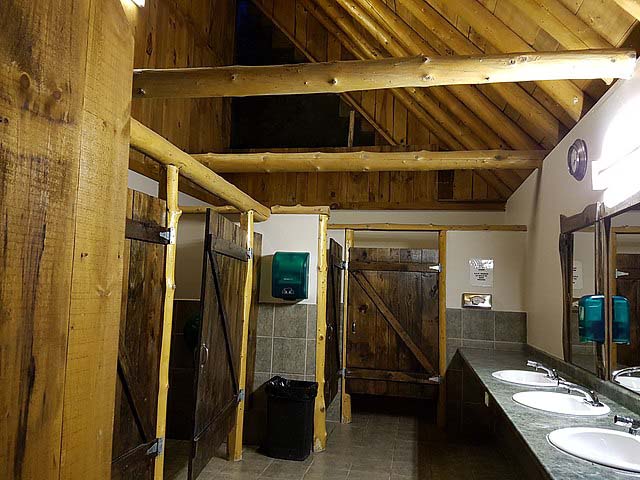
Lots of campgrounds have flush toilets. If this is the case, then you can deal with your period just like you would at home.
Just be warned that tampons shouldn’t ever be flushed in camp toilets. You not even supposed to flush them at home because they clog sewer systems. Campgrounds probably don’t have the best sewer systems, so it is even more important that you put used tampons in the trash can and not flush them.
*Many campground bath stalls don’t have trash cans in them! That’s because they don’t want animals going into the bathrooms to get to the trash. Be prepared to put your used tampons or pads in a baggie and carry it to the trash can!!!
**Remember also that you might be on day hikes. So, even if there is a flush toilet at the campground, you might have to use an outhouse or dig a cat hole.
Option 2: Outhouses
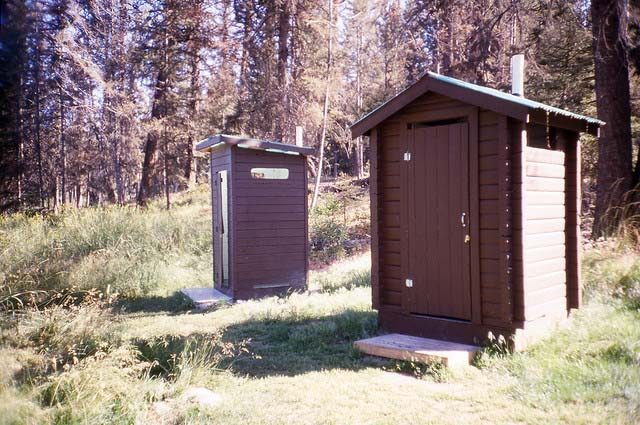
You might think that you can just toss your pads, tampons and baby wipes into an outhouse. But this is always not the case!
Under no circumstances should you put tampons, pads or wipes in a composting outhouse or toilet!
The main reason is because tampons, pads and baby wipes contain plastic in them (yes, tampons and baby wipes have plastic fibers!!!).
The plastic won’t break down and will create microplastics in the ground. I know a lot of women throw their tampons in composting outhouses or toilets, but you really shouldn’t do this!
One solution is to get 100% natural, biodegradable tampons. There are also some natural baby wipes and plastic-free pads that could go into an outhouse (see list of products at the end of the post). But still check with the campground or Parks Service to see if it is okay to put these products in the outhouses.
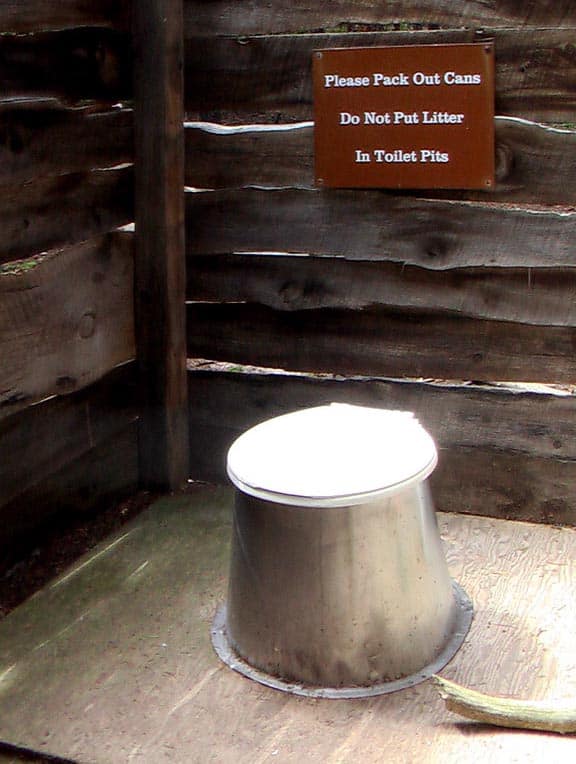
Option 3: No Toilet (Cat Hole)
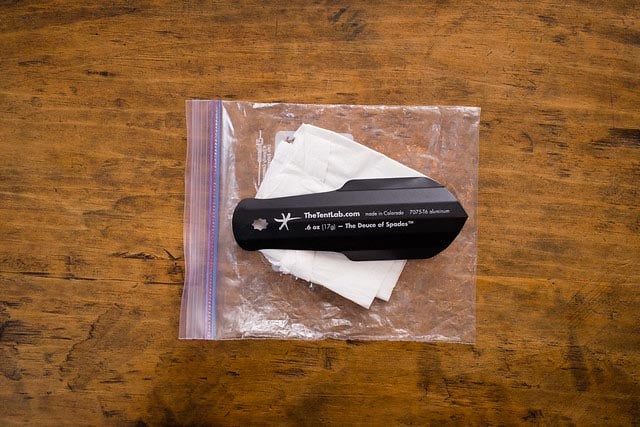
When there is no toilet around, you’ll have to dig a cat hole for poo or menstrual blood. Cat holes should be 6-8 inches deep and at least 200 steps from a water source.
In this case, menstrual cups will make your life much easier. You just dig a cat hole and empty the blood into the hole. Cover the hole and you are done.
If you are using tampons, you will have to pack them out. Tampons should never, ever be buried! The same goes with pads.
Why? Aside from the fact that tampons and pads take a really long time to degrade (even the “natural” kind), the tampons and pads smell. Animals will dig up tampons and pads and eat them.
As one camp counselor said about all the girls who improperly dispose of period products outdoors, you don’t want to see what the animal poop around here looks like!
What to Do with Bloody Toilet Paper?
Under the rules of Leave No Trace, you are supposed to pack out used toilet paper (I actually use a homemade pee cloth instead of toilet paper). The reason for doing this is that even TP takes a long time to decompose. However, there are some situations where it’s okay to bury toilet paper.
Pack out TP if:
- The rules say you must.
- It isn’t likely to decompose quickly, such as sandy or arid areas.
- You are above treeline and/or in a fragile environment.
- The TP isn’t biodegradable or has perfumes/additives.
- It’s a heavily used area.
You can make packing out TP less gross by…
- Use a doubled zip lock baggie
- Line the baggie with aluminum foil so you don’t have to look at the contents.
- Or cover the outer baggie with duct tape.
- Put a teaspoon of powdered bleach into the TP baggie before you leave. It will help with the smell.
What about Wet Wipes?
DO NOT BURY WET WIPES. Wet wipes take even longer to degrade than toilet paper. Most of them have plastics in them which will not break down at all. They leave behind micro plastics in the ground. Wet wipes also often have chemicals and perfumes in them. Wet wipes aren’t even supposed to go in outhouses.
Don’t believe me? One backpacker did a test to see how long it takes TP vs. biodegradable wipes vs. normal wipes to degrade in a cat hole. After 6 months, the TP and biodegradable wipes were gone but the normal wipe was almost perfectly preserved.
Ideally, you should pack out all wet wipes. If you don’t want to carry them around, you can burn them over a campfire. It will need to be a fairly big or long-lasting campfire to dry out the wipes though.
There are some brands of eco-friendly and compostable wet wipes (like the ones by Eco by Naty, Jackson Reece, and Surviveware). Biodegradable wipes *can* be buried them with your period waste in a cat hole. But it’s still not recommended. Just use toilet paper or pack out the wet wipes and throw them away later.
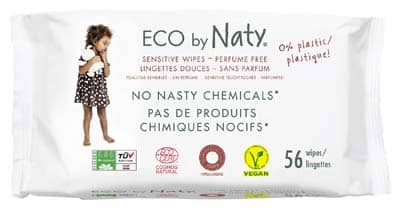
These compostable wipes by Eco By Naty can be buried (but it’s still better to pack them out!). Get them here.
*Flushable does not mean the wipes can be buried. They must be labeled as COMPOSTABLE. They also should be unscented so you don’t attract animals.
**Alternatively, consider making your own wet wipes. This can be done by wetting paper towels with a solution of water, coconut oil, eco-friendly baby wash, and tea tree oil. See the instructions here.
Option 4: Cleanwaste WAG Bags
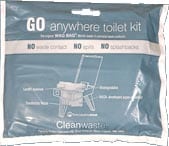
Cleanwaste bags (formerly called WAG bags) are really cool. They are bags with a special gelling agent in them. When you go to the bathroom in them, the gel renders your stool inert and odorless. You then seal the bag and can throw it away in the regular trash.
In places with very fragile ecosystems, like at Mt. Whitney, you will be required to use a WAG bag.
WAG bags can also be great for dealing with your period. Instead of digging a cat hole, you just put your tampons into the WAG bag or dump your menstrual cup into it. Toilet paper and wipes also can go in the WAG bag.
Because there are no odors, you don’t have to put the used WAG bag in a bear canister. They aren’t supposed to leak, but you still might want to keep it in a trash bag at the bottom or outside of your pack anyway.
The only issue with WAG bags is that the cost can add up. Depending on how many bags you buy at once, expect to pay anywhere from $1 to $3 per bag. There is enough gelling powder in each bag for 3-4 uses, so you don’t have to seal them right away. You can also change menstrual products while you poo so it all goes in the bag at the same time. But still plan on using at least 2 WAG bags per day.
*You can get a 12 pack of Cleanwaste bags here. Or get a 50 pack here.
Using a Menstrual Cup while Camping
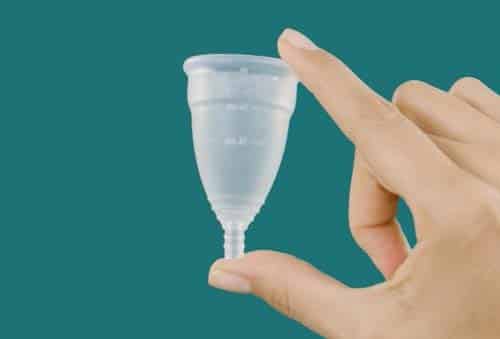
I have been using a menstrual cup for nearly 20 years now (yes, that makes me one of the “early adapters”). Since starting with a menstrual cup, I haven’t looked back. I really can’t understand why someone would use tampons. I even have bought a lot of my outdoorsy and traveler friends menstrual cups as presents. They are all really happy with them. 😀
Menstrual cups have a lot of benefits, like being eco-friendly and saving you oodles of money on tampons. They also don’t leak like tampons do (at least I always had problems with tampons leaking but never with my Diva Cup).
Choose a Menstrual Cup If:
|
The Good and Bad of Menstrual Cups in the Great Outdoors
Good: No Waste to Deal with
I go camping in places where there aren’t any bathrooms or even outhouses. If I were to use tampons, I’d have to pack them out. As I talked about in the tampons section, you absolutely can’t bury tampons or pads in nature.
All I need to do is dig a cat hole for going to the bathroom and dump the blood into the hole. The cup gets rinsed off and reinserted.
Good: Only Need to Be Emptied Two Times Per Day
This is probably the best benefit of choosing a menstrual cup while camping. Since they don’t fill up quickly like tampons or pads, you can go a really long time before you need to empty the cup. So, you can wait until it’s a good moment to empty – like when you have access to a proper toilet or have extra water for washing your hands.
On my heavy flow days, I do need to empty the cup 3x or it will start to leak. On my light days though, I can even go the entire day without emptying the cup.
Good: Don’t Have to Lug Around Tampons
If you are car camping, then this isn’t really a big deal. But I carry everything in my pack. Space is at a premium. I’m happy that I only have to carry a small cup that weighs practically nothing. If I ever go on a long thru-hike, I’d be saving tons of room in my pack.
Bad: The Learning Curve
As much as I love my menstrual cup (as much as you can love a hygiene item, anyway), I wouldn’t recommend trying one for the first time while on a camping or backpacking trip.
Menstrual cups do have a bit of a learning curve. You don’t want to be figuring out how to use one while you are squatting over a cat hole! Ideally, you should use a menstrual cup for at least once cycle before taking it on the road.
Bad: Yes, It Can Be Messy
I’m not going to lie: menstrual cups can be very messy. You will get blood on your hands. You will find yourself in awkward situations – like squatting over a toilet while you hold a bloody cup in one hand and try to tear TP with the other hand!
Even as someone who has used menstrual cups for 16+ years, I still had some issues the first time I went camping on my period.
Bad: Dirty Hands when Emptying Cups
Probably the most difficult part of using a menstrual cup while camping is that you should have clean hands when you change it. In campgrounds with flush toilets, this isn’t an issue. Just wash your hands before entering the bathroom stall.
With outhouses, it can be pretty gross. You have to touch the outhouse door to enter. There isn’t anywhere inside the outhouse to lay out your kit.
Menstrual Kit for Backpacking
I like to keep all my hygiene items together in a baggie so they will be ready when I need to use them. If you are going to be using an outhouse, it really helps if you have a way to hang the kit around your neck (like using a drawstring bag). You don’t want to lay it down on gross outhouse floors!
The kit should contain:
- Bag for carrying all the items
- Biodegradable soap
- Antibacterial hand gel
- Toilet paper
- Biodegradable baby wipes*
- Shovel/trowel (if you will have to dig a cat hole)
- A bottle of purified water
How many baby wipes to bring?
You don’t have to use baby wipes, but it’s a lot easier to clean yourself with wipes than TP (especially if you get blood on your hands).
I use approximately 3 wipes per menstrual cup dump. Once you get the hang of it, you might only need 1 or 2 wipes per dump. You can also use a combo of TP and baby wipes.
My period lasts 6 days. I dump the cup 2x per day. So, that means I bring 36 wipes per menstrual cycle.
Instructions for Using a Menstrual Cup Outdoors
It can be a bit tricky the first few times you try using a menstrual cup outdoors. Think blood and dirt all over your fingers as you wonder how the hell to get the cup clean and reinserted! Once you get the hang of it, you’ll probably find it easier than dealing with tampons.
*These instructions are for it you don’t have a toilet. If you are using a menstrual cup in an outhouse, the instructions are mostly the same. You will just have to be creative with a way to set up your supplies inside the outhouse. You’ll definitely want to sanitize your hands after touching the outhouse door!
1. Get all Your Hygiene Supplies Ready
Seriously, have everything ready. I will even pre-tear TP and remove some wet wipes so they can be grabbed easily. You don’t want to be caught with a bloody cup in your hand and not have supplies ready!
2. Dig a Cat Hole
It should be as deep as your hand and at least 200 steps away from any water source. You also want to make sure your cat hole is 200 steps away from camp.
3. Wash/Sanitize Your Hands
I usually do this by pouring a bit of water over my hands to get the dirt off and then washing with soap. A bit more water removes the soap. Then I put a glob of antibacterial hand gel on my hands.
4. Remove the Menstrual Cup
I always remove the cup first and dump the contents. Then I will pee/poo. I make sure to only touch the menstrual cup with one hand. On heavy flow days, my hand usually doe get some blood on it.
5. Wipe
Either bury or pack out the TP. Baby wipes should be packed out if they aren’t biodegradable.
6. Clean the Cup
Using your other hand (the one not holding the menstrual cup), pour a bit of water in/on the cup to get blood off. I’ll do this by slightly loosening the lid on my water bottle so only a trickle of water comes out. Loosen the lid BEFORE you get started!
Never use antibacterial hand gel to clean a menstrual cup. The alcohol in it can degrade the silicone that the cup is made from.
Instead of rinsing it with water, you can wipe the menstrual cup with a baby wipe.
7. Reinsert the Cup
It often takes two hands to insert a menstrual cup (because you need to fold it into shape). If you are worried that the hand you wiped with got some poo on it, put a bit of antibacterial gel on your hand first. You don’t want to insert a menstrual cup with poo hands!
8. Clean Hands
I will use another baby wipe to clean any blood off my hands. It gets thrown into the cat hole (or in the pack-out bag). Now you can fill the cat hole and wash your hands with soap and water. You are done!
Cleaning Your Menstrual Cup while Camping
At home, I will wash my menstrual cup with soap and water each time I empty it. At camp, I just rinse it with purified water or maybe wipe it with a baby wipe.
This should really be adequate to keep your menstrual cup clean and sanitary. Once my period is over, I do properly clean the menstrual cup with soap and water. Then I boil it for 5 minutes to kill any bacteria. I also boil it again before using it on my next period.
Yes, I do use my camp cooking pot for boiling the menstrual cup. Does it seem gross to use the same pot for my menstrual cup as I use for food? Sure – but it has been boiled long enough to kill any bacteria, so I’m not concerned. I get that there still might be a yuck factor though. So, either wait until you get back home to boil the menstrual cup or bring a separate small pot just for boiling your cup.
Tampons and Pads while Camping
Since switching to a menstrual cup, I have only used tampons or pads on very rare occasions (like when recovering from a C-section). So, I don’t have any personal experience using these while camping on my period. However, I can still see the good/bad in them.
The Good and Bad
Good: Easy to Use
If you don’t have experience using a menstrual cup, a camping trip is not the time to get started! Stick to what you know. You can always get a menstrual cup later and try it out. Once you get the hang of it, you can bring it on future camping trips.
Good: No Worries about Dirty Hands
If you are using an outhouse or digging a cat hole, your hands will get dirty. You really don’t want to insert a menstrual cup with dirty hands. This isn’t an issue if you use pads or tampons with applicators.
Bad: You Probably Need to Pack Them Out
When you’ve got a trash can nearby, using pads and tampons while camping is pretty easy. But what about all those times where there is no trash can?
Tampons and pads can’t go in flush toilets or outhouses. They definitely can’t be buried in cat holes. So, you MUST bring a baggie for storing your used hygiene items until they can be thrown away or burned.
Bad: Take a Long Time to Burn
Instead of lugging a baggie of used tampons around with you on the trail, you can burn them. However, it takes a long time to completely burn tampons – even on large, roaring campfires.
Bad: May Attract Wild Animals
Your used pads and tampons might attract wild animals. If you can’t throw them away or burn them right away, you’ll have to store them in a bear canister (with your food, gross!), in a bear bag, or your car.
Even unused pads and tampons might attract wild animals. That’s because most feminine products have all sorts of perfumes added to them. So, even these have to be stored in a way that’s safe from animals. Definitely don’t keep them in your tent or you might wake up to an unwelcome intruder. 😮
Bad: Take Up Space in Pack
On longer backpacking trips, pads and tampons can take up much-needed space in your pack. You can remove the applicators to save space, but then you have to insert tampons with your dirty backpacker hands.
Since tampons/pads expand when used, they will take up even more space in your pack once you’ve used them.
Bad: Eco-Friendly Options are Pricier
There are now plenty of options for eco-friendly tampons that can go in outhouses. Likewise, there are even some pads without plastic that you might be able to put in outhouses. However, they definitely cost more than regular tampons and pads.
Oh, and even normal tampons that are odor-free tend to cost more. Sucks that we have to pay to keep perfumes and chemicals out of privates!
*See the list of recommended feminine products for camping at the end of the post.
How to Dispose of Tampons and Pads while Camping
Please don’t be an inconsiderate camper and throw away pads or tampons where you shouldn’t! I know it is gross to carry around a baggie of used tampons or pads, but it is necessary. They take a very long time to decompose – even the “biodegradable” kind.
When camping at a campground, call ahead to ask what their policy is for disposing of feminine items.
Ask the Campground:
- Can you flush biodegradable tampons?
- If there is an outhouse, can you put biodegradable tampons in it?
- Are there trash cans in the bathroom stalls, or do you need to carry used items to an outside trash can?
- Is it okay to keep scented tampons or pads in your car? If not (or you don’t have a car), are storage lockers provided at camp for scented items?
Packing Out Pads and Tampons
If you will be required to pack out pads or tampons, you will need to prepare a “pack out bag.”
- Get two quart-sized zip baggies. Make sure the baggies are made from a thicker material. Preferably they have slide zips and NOT the “press to close” types of zips. If you are using pads, you’ll need even bigger baggies, or will need to make two pack-out bags.
- Put one baggie inside the other.
- Cover the outer bag with duct tape (optional): Alternatively, you can line the inner bag with foil. This makes it so you can’t see the contents of the bag.
- Put 1 tsp. of powdered bleach into the inner baggie: Borax also works.
After going to the bathroom and tending to your period, just put used tampons or pads into the baggie. Wet wipes should also go into the baggie. Likewise, you should pack out your TP in many situations, like in fragile environments or highly-used areas.
How to Carry/Store the Pack Out Bag?
Used TP, wet wipes, pads, and tampons should be treated like any other scented item. That means it needs to be stored in a way that is safe from wild animals. You definitely don’t want animals getting into your tent because they smelled your used tampons!
If you have a car, then you can just keep the Pack Out Bag in there. Or maybe the campground has special lockers where you can keep scented items.
When backpacking though, you’ll need to put scented items – including your gross Pack Out Bag – in a bear canister or hang them in a bear bag. Do this even if you aren’t in bear country! There are plenty of other wild animals that will be attracted to scented items.
This creates an annoying problem: Do you really want to store your Pack Out Bag with your food? One option is to hang two bear bags (if you are even in an area that permits bear bags).
I am terrible at hanging bear bags. My throwing arm sucks, and it takes me forever to get the rope over an appropriately-high branch. If I had to pack out items and hang them, I’d use the Counterbalance method so I would only need to throw rope one time.
Or, just suck it up and keep the baggie in your bear canister.
Pads and Tampons in Bear Country
According to the National Parks Service, being on your period doesn’t attract bears to women. However, they also say that women should “use internal tampons instead of external pads.” That makes sense – using pads is definitely going to make you smell much more of blood than tampons or a menstrual cup.
They don’t mention anything about hiking with a stinky Pack Out Bag full of used tampons. If the blood on pads might attract bears, wouldn’t the smell of blood emitting from your pack also attract bears? I would suggest getting an odor-proof bag for keeping your stinky waste in while hiking.
The NPS also warns that you should not use heavily scented pads or tampons. The scents might attract bears.
The bottom line? It’s probably best to use a menstrual cup in bear country. If you use tampons, make sure you are storing them as you would any other scented item at camp: in an approved bear canister or in a bear bag. As an extra precaution, put them in an odor-proof bag while you hike.
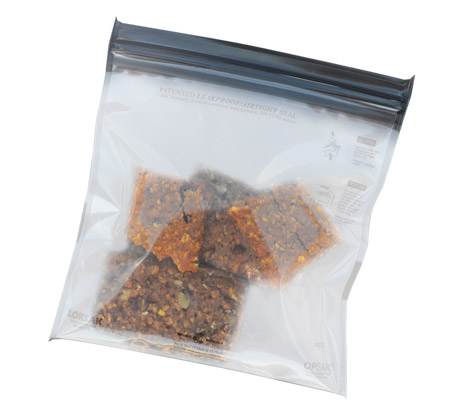
These odor-proof bags by Loksak are popular with backpackers. Put food, scented items, and used hygiene items in them to keep animals away. Get them here.
Biodegradable Feminine Hygiene Items for Camping
Here’s an overview of tampons, pads, and wet wipes that are biodegradable and scent-free.
Menstrual Cups
There are a lot of different menstrual cups to choose from. Over the past 16 years, I have tried two brands: Diva Cup and Dutchess Cup. The Dutchess was cheaper, but the silicone started to lose its shape after a year and began to leak. I switched back to a Diva Cup. I’ve never had leak problems with Diva Cup, even after using the same cup for 5 years.
I haven’t personally tried it but Lunette Cup is very popular.
Tampons and Pads
All of these tampons and pads are scent-free, all-natural, and biodegradable. Again, always check with the campground or Park Service before putting these in an outhouse. If you have to pack them out, make sure they are stored in a way which is safe from wild animals.
Tampons:
- NatraCare tampons with cardboard applicator
- Cora tampons without applicator (or with plastic applicator)
- Veeda tampons without applicator (or with plastic applicator)
Pads:
*Note that I wouldn’t recommend using reusable cloth pads on a camping trip. Packing out all those bloody pads would be stinky and attract animals.
Wet Wipes
All these wet wipes can go in composting outhouses. You *can* bury them in a cat hole too, but it’s still not recommended. Use toilet paper instead or pack out the used wet wipes to throw away later.
*Note that flushable does not mean the wipes are biodegradable. They must be labeled as COMPOSTABLE.
Alternatively, consider making your own wet wipes. This can be done by wetting paper towels with a solution of water, coconut oil, eco-friendly baby wash, and tea tree oil. See the instructions here.
Ladies, any tips about camping on your period? Let us know in the comments section below!
Did you know that I wrote a book?
If you aren’t sure what to eat while backpacking, check out my eBook. It’s got tons of info on how to plan backpacking meals, trail nutrition, and over 50 ultralight recipes that you can make on a dehydrator. Learn more here.
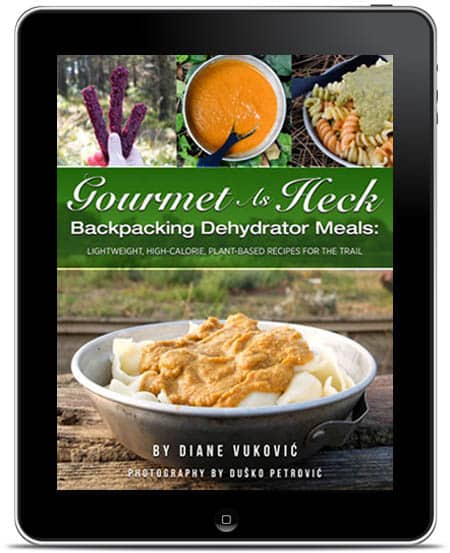
Resources:
https://outdoorluxuriez.com/should-you-bury-used-toilet-paper-or-pack-it-out/
https://cabinlife.com/articles/article/maintaining-the-outhouse
https://www.theguardian.com/environment/2016/nov/20/the-eco-guide-to-wet-wipes
https://thedyrt.com/magazine/gear/wag-bag-camping-waste/
Image credits:
“Ocean Cove, California” (CC BY-SA 2.0) by Joe Hoover
Torben T. Koch / Wikimedia Commons / CC BY-SA 4.0
“Mt Rainier (Sunrise – Burrough’s Peaks –” (CC BY 2.0) by Rick McCharles
“climbing Longs Peak, Rocky Mtn National” (CC BY 2.0) by Rick McCharles
“outhouses” (CC BY-NC-ND 2.0) by Duncan Creamer
“Open Outhouse at Boreas Brook Campsite” (CC BY 2.0) by andyarthur
“Potty Trowel” (CC BY-NC 2.0) by azoeart


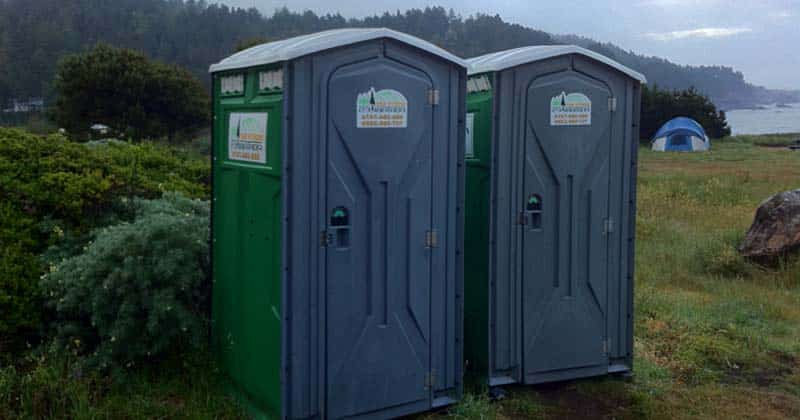
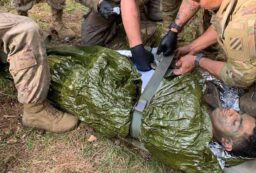
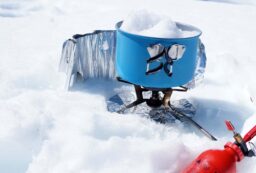








1 Comment
Kimmi
April 12, 2023 at 5:51 amWhen they were first married my partner and I invited my brother and our new sister in law on a long back country trek.
She was new to the whole thing but had heard about bears and period blood so I ended up having a long conversation with her about her cycle and birth control.
That is how I found out she was not on the pill and was using a diaphragm for birth control. Anything that has to be washed daily with soap and air dried is not very practical for camping, but whatever. My partner and I were trying to conceive at the time, so the whole idea of spending ten days with someone who was fertile and trying NOT to get pregnant was more than a little annoying.
Trekking is about getting back to nature, right? So her birth control somehow “fell out” of her pack before we started the trail.
There’s not a lot of privacy when it’s just the four of you camping and bedding down a few feet apart. Even though she was trying to whisper, we heard the whole story our first night about how she couldn’t find her birth control and they “couldn’t risk it” because it was “a bad time.”
Of course I knew that week was perfect timing for her to get pregnant.
My partner and I made no attempt to hide how much fun we were having trying for a baby just a few feet away while she was whispering about birth control. It was summer and the fire was still glowing, so they got quite a view.
Her “we can’t” went to “it’s risky” to “please be careful” to “I’ll get pregnant.”
Which is exactly what happened. For both of us!